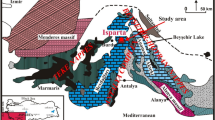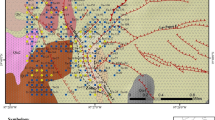Abstract
This paper describes the results of in-situ measurements of magnetic susceptibility in landslide deposits along the Tsurukawa fault zone in central Japan. The measured magnetic susceptibility values range from 0.4 to 9.6×10–3 (in SI) and correspond to the proportions of the two component materials, weathered volcanic ash and faulted rock fragments. The study shows that landslide deposits along the Tsurukawa fault zone are composed of varying proportions of weathered volcanic ash. The results contrast with some general assumptions concerning landslides along fault zones in Japan.
Résumé
L'article décrit les résultats de mesures in-situ de la susceptibilité magnétique de matériaux glissés le long de la zone faillée de Tsurukawa, dans le Japon central. Les valeurs de susceptibilité magnétique mesurées varient de 0,4 à 9,6×10–3 (en S.I.) et correspondent aux proportions de deux composants, des cendres volcaniques altérées et des fragments rocheux. L'étude montre que les matériaux glissés le long de la zone faillée de Tsurukawa sont composés de quantités variables de cendres volcaniques altérées. Ces résultats font contraste avec des hypothèses générales concernant les glissements le long des zones de faille au Japon.
Similar content being viewed by others
Author information
Authors and Affiliations
Additional information
Received: 16 April 1999 · Accepted: 10 August 1999
Rights and permissions
About this article
Cite this article
Kosaka, K. Evaluating landslide deposits along the Tsurukawa fault zone, Japan, using magnetic susceptibility. Bull Eng Geol Env 58, 179–182 (2000). https://doi.org/10.1007/s100640050073
Issue Date:
DOI: https://doi.org/10.1007/s100640050073




